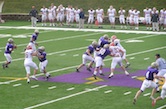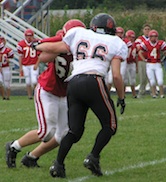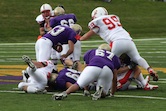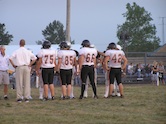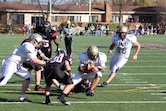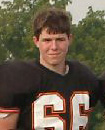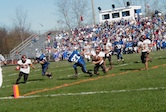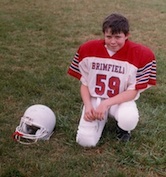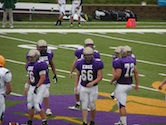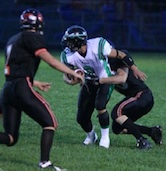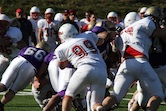Bringing the Punch

Weeks without football are like a barren wasteland.
A Weekly Review of Football by Alex Davis
Playbook:
This week I am going to explain a series of plays that you see at every level from high school to the pros, inside zone. Most college teams and every pro team run some sort of inside zone play, in fact it may be the single most common running play in football right now. This is because it is simple to teach, and since the offensive line is blocking an area rather than a man it does not matter what front or stunts the defense brings; if the O-lineman follows his rules and executes, the play will have a great chance of being successful. Another reason why inside zone is so ubiquitous is that it allows for double teams on most down defensive lineman, while still being able to account for the linebackers. This play is also popular because if blocked well it allows for the back to run downhill immediately, have a choice of which hole to run in, and it provides good cutback lanes.

Brian Balaga
There are several rules that an O-lineman lives by when he is running inside zone. We ran this when I played at Knox and these rules were so ingrained in my memory that they became second nature. A lineman's first assignment on this play is always very simple, just block your play side cylinder. This means that if the play is called to the right you block anyone who is in the gap to your right. Pre- snap then an O-lineman checks his cylinder for any immediate threats such as a defensive lineman or a walked up linebacker. For example if you are playing left guard and the play is inside zone left and you have a defensive lineman lined up in a three technique (on your outside ((left)) shoulder) he is the one who you should expect to block. Defensive lineman however do not always stay in the gaps they lined up in when the ball is snapped. So when the ball is snapped the O-linemen must read the shoulders of the defender in his cylinder. If the shoulders are going away he must not chase and instead climb straight up field and be ready for a defender coming to fill his cylinder. An offensive lineman must never chase in Inside zone as it will open up gaps for linebackers to shoot through and make a tackle in the backfield.

always looks good in the x's and o's
If no one is in your cylinder pre-snap and no one threatens at the snap of the ball then the Offensive lineman can feel back for a clamp. A clamp is used when after taking your first play side step you have no threat in your cylinder, so you then bring your second step straight back up the field and punch with your backside hand in order to help out your fellow o-lineman. This keeps the defensive lineman from closing down running lanes by chasing the play, creates a temporary double team, and allows you to come off to block any linebacker who shows in your cylinder. While clamping it is vital to keep your play side arm free, stay on balance, and to keep your eyes in your cylinder so you can be ready to take on any linebacker who enters it.
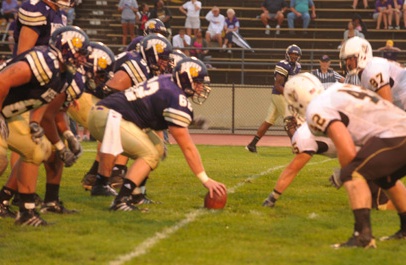
Leatherneck Line at Valparaiso
When running inside zone the most important thing to remember is that you cannot allow the defensive line to penetrate the backfield. Penetration creates a "bubble" which forces the back to make his cut too early thus making the linebackers job much easier. The offensive lineman does not necessarily have to blow his man off the ball, but he must at least stop him from penetrating. Oftentimes an effective blocking technique is to push the defender the way he is already going and use his own momentum to take him out of the play. The longer the offensive lineman can hold their blocks and the more movement they can create, the more time the back has to push the line of scrimmage before he has to make a cut. This keeps the linebackers guessing and allows the running back a choice of whether to follow the play as called or to cut back against the grain if the linebackers have over pursued. These cutbacks often result in huge runs if the offensive linemen have successfully used their clamps to get linebackers blocked. Inside zone runs are simple plays but when blocked correctly they are an extremely effective part of any offense.

Green Bay in the Day - looks like a pass in Super Bowl I - Max McGee running free

